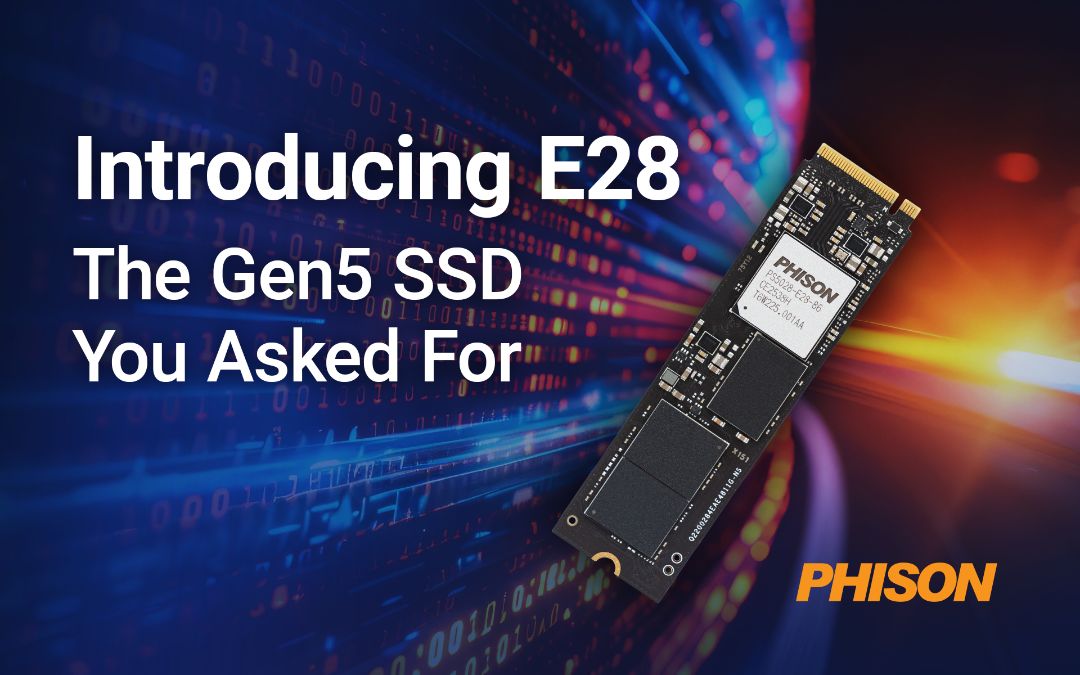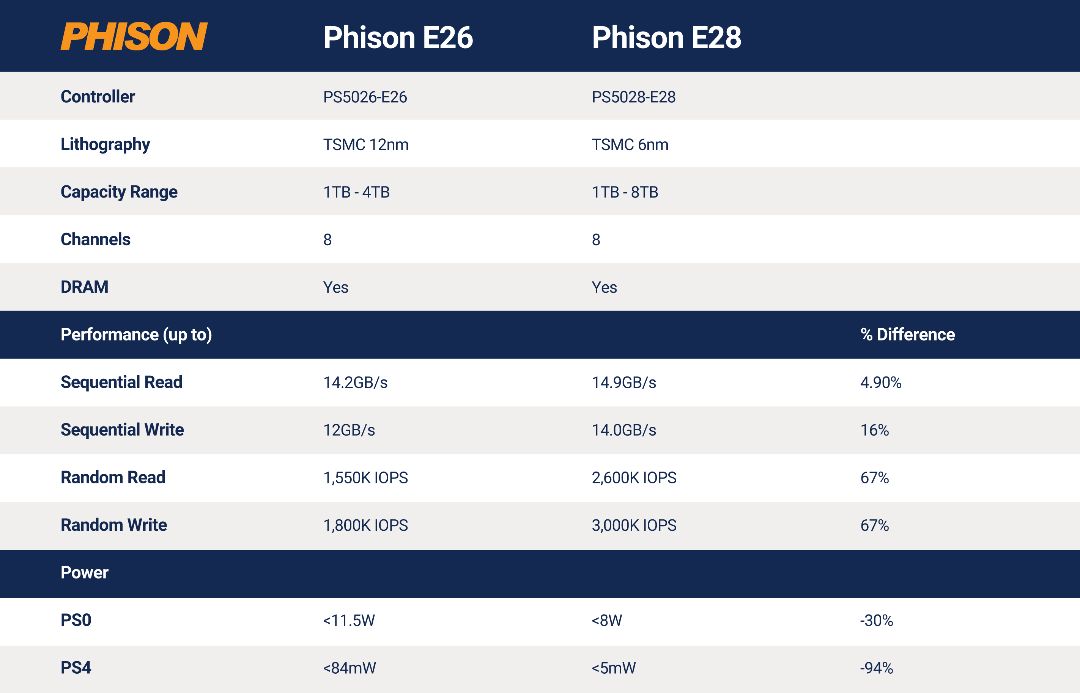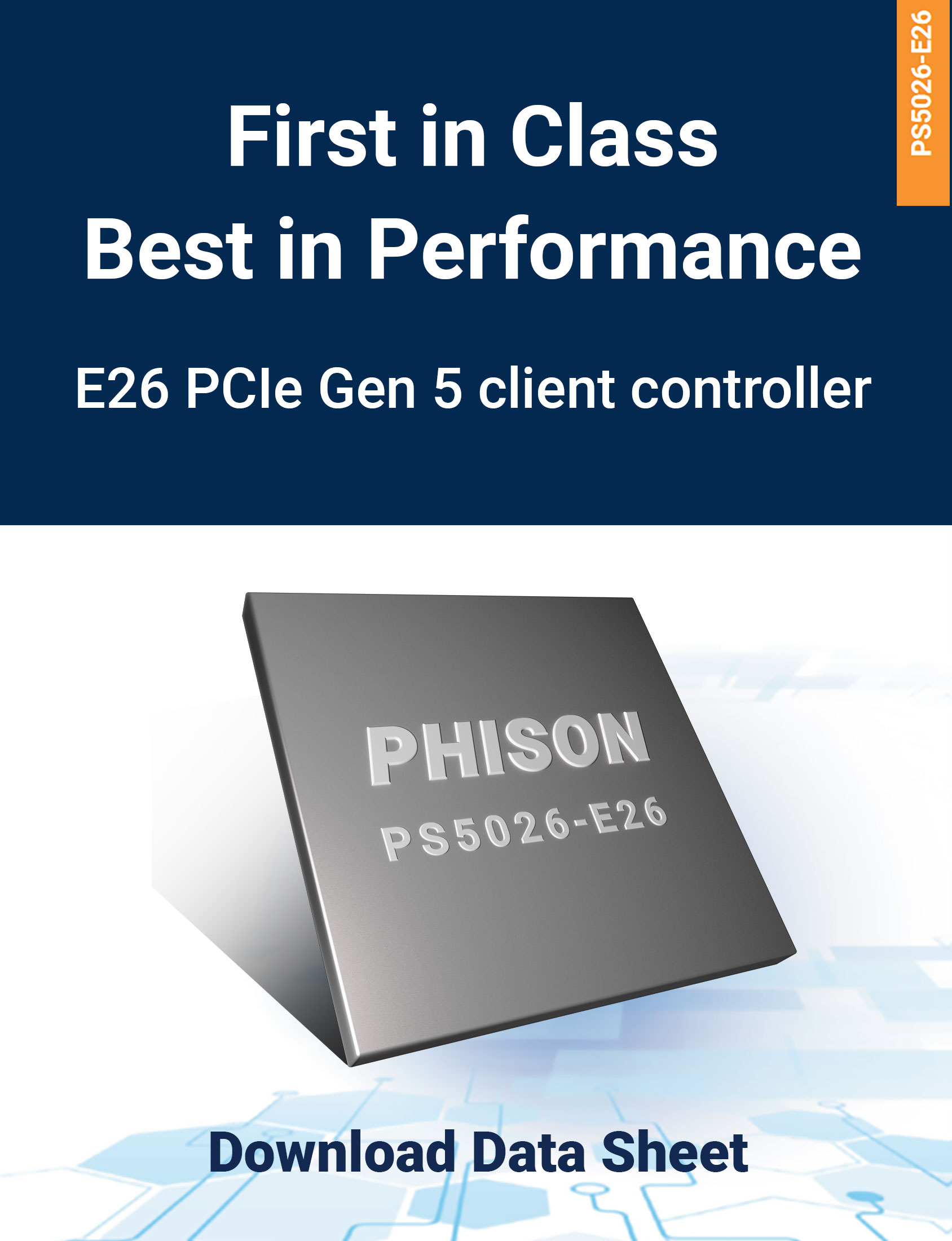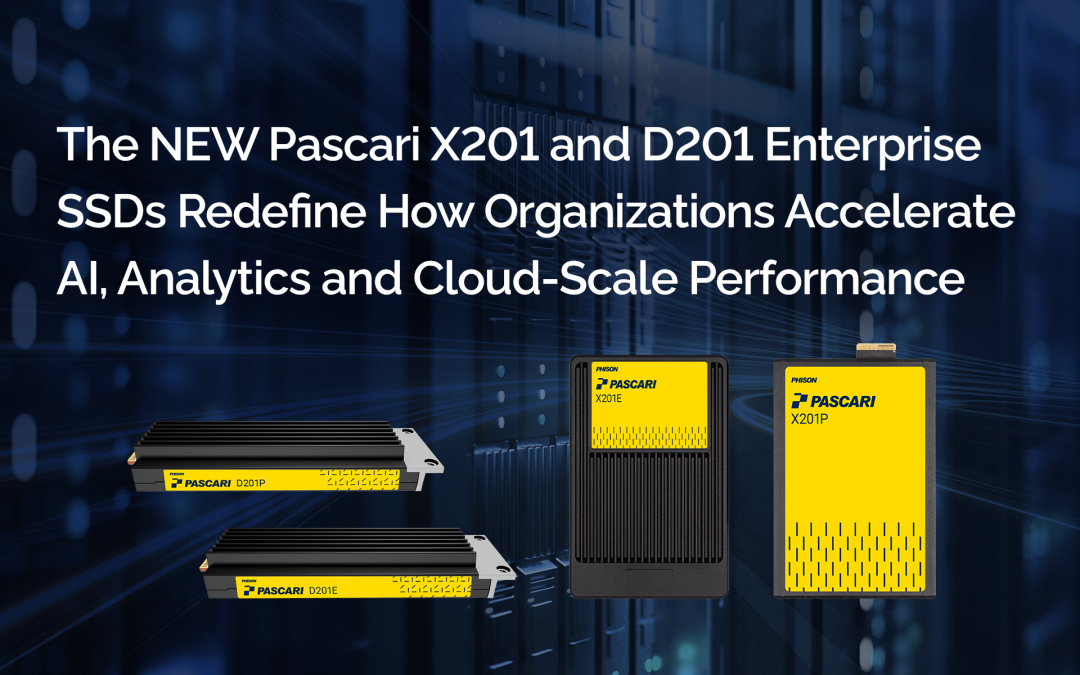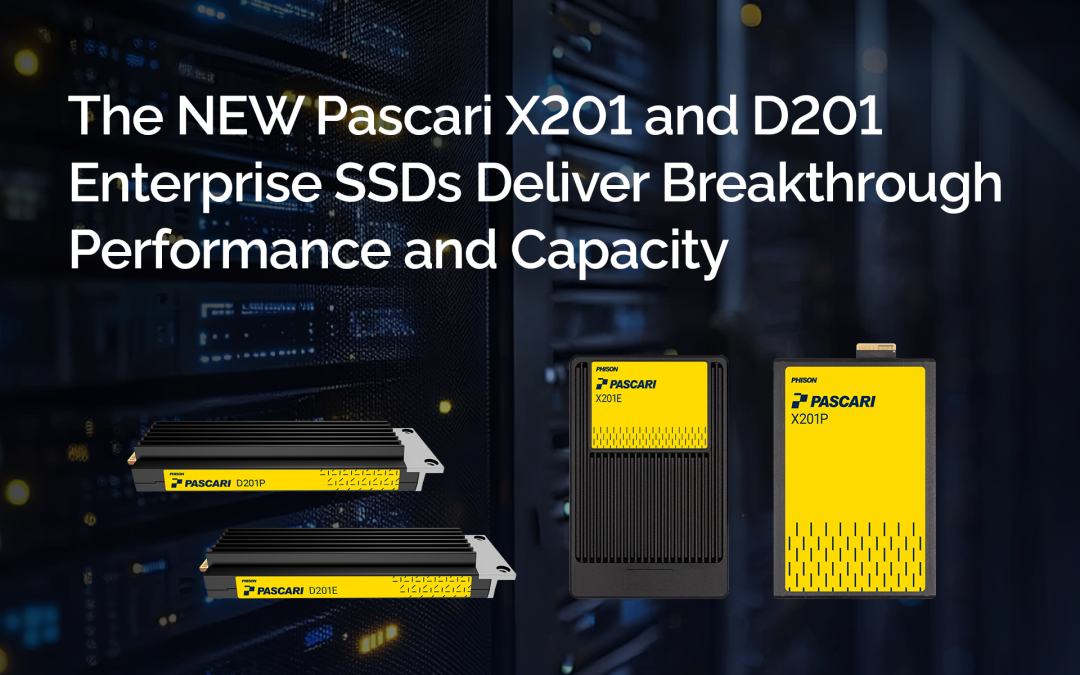對於群聯電子來說,Computex 2025 是即將推出的 PS5028-E28儘管我們在展會上發布了幾款出色的產品,例如新款 X200Z SLC 企業級快取 SSD,補充了我們的 D200V QLC 系列,以及 PS5031-E31T 的新外形尺寸,很難掩蓋這款高聳的旗艦產品。新款 E28 曾是 電腦展 並贏得了多個值得信賴的媒體頒發的「Computex 最佳」獎項,這些媒體都熱衷於測試這款全新的一流發燒友硬碟。
E28 控制器(圖片由 FPS Review 提供)
認識 Phison E28
我們於 1 月初在 CES 2025 上首次發布了 E28 控制器。當時的新聞稿只是粗略估計了這款 8 通道控制器的性能,旨在取代當時佔據主導地位的 E26。 PCIe Gen5 固態硬碟 市場上一年多來一直沒有競爭對手。然而,有了 E28,我們把它調高到了 11……好吧,實際上是 14.9!
將新款 E28 與舊款 E26 的規格進行比較,我們更能體會到群聯研發團隊的辛勤付出。升級到台積電 6nm 製程節點後,閒置和滿載功耗均顯著降低。這使得 E28 能夠運行 2400 MT/s 的 NAND 閃存,且性能絲毫不受影響。結果,順序讀取效能提升了近 5%,順序寫入效能提升了 16%。隨機效能也獲得了更大的提升,讀取和寫入都大幅提升了 67%。 (本文稍後將展示這在實際性能中的意義。)
功耗是一個無需複雜圖表就能理解的領域,尤其是在本例中。 E26 幾乎不可能在筆記型電腦上使用。在桌上型電腦上,E26 產品需要散熱器。 E28 的有效功耗降低了 30%,空閒功耗降低了 94%,因此無需散熱器即可在筆記型電腦甚至桌上型電腦上運作。我們仍然建議使用主機板自帶的散熱器來搭配 E28,但這只是為了防止在長時間運行工作負載(例如海量文件傳輸)時出現過熱現象。不過,這並不是必要的。
規格中未列出群聯所使用的 NAND 型別。 E28 憑藉 2400 MT/s NAND 性能,在 2025 年高端 SSD 競爭中勝出,而我們的競爭對手則被迫使用 3600 MT/s NAND,這會導致功耗更高、發熱量更大。
利用速度較慢的 NAND 的能力證明了 Phison 的卓越控制器架構,它混合使用了大型和小型計算核心。較小的核心被稱為 CoX 處理器,效率極高,旨在運行垃圾收集等後台活動。與其他 SSD 市場相比,這代表著一項根本性的設計變革,其他 SSD 廠商通常會在控制器中添加更多 ARM R5 和 ARM R8 核心。而我們的許多競爭對手在 Gen5 設計中最多使用了五個效率較低的核心。
E28 實際性能
使用搭載英特爾酷睿 i9-14900K 和 Z790 晶片組主機板的 E26 處理器,我們在 PCMark 10 測試中實現了比基礎版 E26(配備 2000 MT/s NAND)高出 24.28% 的效能提升。這項測試衡量的是我們大多數人每天都在使用的實際應用程式的工作負載軌跡。即使使用測試版韌體,新款群聯 E28 的性能也遠遠領先競爭對手。我們預計,在韌體針對實際軟體和資料傳輸進行全面優化後,零售版產品的效能將進一步提升。
Phison E28 與競爭對手的吞吐量比較。
功率比較
自從群聯電子 (Phison) 於 2024 年初發布搭載 E26 晶片的產品以來,關於第五代固態硬碟 (Gen5 SSD) 的功耗討論就一直持續不斷。部分資訊準確,但很多也被曲解了。 E26 晶片根本不需要散熱器上的風扇,只要機殼內保持良好的氣流即可。一位競爭對手聲稱,他們的第五代旗艦產品(同樣採用台積電 6nm 技術)的功耗不到 5 瓦,我認為這是資訊失實。經測試,我們發現該說法具有誤導性,如上圖所示。
看看專業評論家是怎麼說的
2025 年台北國際電腦展 (Computex 2025) 結束後,我們向各大儲存媒體機構寄送了多款 E28 固態硬碟,收集資深專業人士的回饋,並讓大眾搶先體驗 E28 的魅力。以下是一些專業人士的評價。
湯姆的硬件
Phison E28 2TB SSD 評測:復仇歸來
「…如果您正在尋找兼具最佳性能和能效的固態硬碟,那麼您的搜尋就到此為止了。基於 E28 的固態硬碟幾乎適用於任何系統和應用程序,並且在大多數情況下都能比市面上的其他固態硬碟表現得更好。」
存儲審查
Phison E28 SSD 控制器搶先體驗:卓越的 Gen5 速度與增強的電源管理
在我們廣泛的測試中,搭載 E28 的 SSD 始終保持著與頂級第五代固態硬碟相當甚至超越的效能,尤其是在順序和 4K 隨機工作負載下。其隨機寫入 IOPS 達到了無與倫比的 329 萬,讀取延遲也往往優於 SN8100 和 Renegade G5 等競爭對手,充分展現了群聯在底層的精湛調校。
SSD評論
Phison PS5028-E28 Gen5 參考設計 SSD 預覽 – 意想不到的最佳搭配
我非常肯定,Phison PS5028-E28 Gen5 SSD 控制器是第一個在我們的測試中實現低隊列深度 4K 隨機寫入速度超過 500 MB/s 的 SSD。其直接結果是,它提供了我們在 SSD 上見過的最佳實際資料傳輸測試結果,尤其是在傳輸小型 4K 作業系統資料方面。
FPS 評論
Phison PS5028-E28 參考設計 2TB PCIe Gen5 M.2 NVMe SSD 預覽和基準測試
這又是一個基準測試,為了確保效能不會超標,我們不得不多次運行,結果確實如此。群聯 PS5028-E28 參考設計 2TB SSD 在工作站級工作負載下堪稱傑作,其 SPECworkstation 3.1 得分高達 14.2,是我們見過的最高分。在這個效能等級下,它比排名第二的固態硬碟快 66%,比使用速度較慢的 InnoGrit 控制器的 ADATA LEGEND 970 PRO 快 82%,後者在工作站效能方面表現不佳。群聯表示,E28 也是為企業級應用而設計的,SPECworkstation 3.1 證明了其在工作站和企業級領域的卓越性能。
調整者
首款搭載 Phison E28 控制器的 SSD 預覽 (透過Google翻譯)
“群聯電子的 E28 和我們的工程樣品無疑解決了功耗問題。我們測試的這款 2TB 固態硬碟是我們迄今為止見過的最省電的第五代固態硬碟。它的性能也相當出色,即使一些優化仍在進行中,這款固態硬碟在我們幾乎所有的基準測試中仍然保持著最佳或最佳之一的得分。“
Level1Techs(YouTube)
Phison 的全新 SSD 控制器:更好的筆記型電腦電池,更快的效能!
“只需更換 Framework 筆記型電腦中的 M.2 [SSD],我的電池續航時間就能增加 30 分鐘。”
調整鎮
Phison E28 SSD 控制器預覽 – 帝國反擊戰
在我們執行的所有基準測試中,可以說這項測試最能反映典型的消費者用例場景。瞧!另一項基於快閃記憶體的固態硬碟實驗室記錄是由我們E28控制的工程樣品打破的。在最重要的地方,性能發揮到了極致。這項測驗的10K分數已經接近Optane P5800X的水平,而包括P5800X在內,只有三次達到這個紀錄。真是不可思議。
Phison 滿足客戶所需的效能
我將以 Jon Coulter 在 TweakTown 預覽版(連結見上)中的話來結束這篇文章:「群聯儲存帝國強勢反擊。我們今天測試的 E28 工程樣品 SSD 的實際性能與我們目前的性能冠軍 WD_BLACK SN8100 2TB 相當。此外,我們堅信,現在的性能冠軍 WD_BLACK SN8100 2TB 相當。隨著控制器確實會將消費級性能桂冠重新歸還給群聯存儲帝國。
常見問題 (FAQ):
為什麼E28沒有極速NAND也能達到高性能?
控制器級創新。 E28 採用 2400 MT/s NAND,但性能優於那些依賴更熱 3600 MT/s NAND 的競爭對手,這得益於其異構核心設計,並具有高效的 考克斯 處理器處理後台任務(例如垃圾收集)而不是堆疊更多的 ARM R 核心。
有任何針對工作站/教室工作流程的第三方驗證嗎?
審稿者報告了創紀錄或一流的成果: SPEC工作站 3.1 得分 14.2(比下一代硬碟快 66%),並在典型的消費級追蹤測試中表現出色。引述稱其具有“傑作”般的性能和無與倫比的低量子密度 4K 寫入速度。
我們在 Gen5 行銷中看到過有關熱量聲明的任何警告嗎?
一些競爭對手聲稱“<5 W” 沒有 在測試中堅持下來,而 E26 從來沒有 必需的 一個能有效提昇機殼氣流的風扇。 E28 的斷電功能讓散熱更加容易控制。
校園 IT 有哪些配置指導(容量、DRAM、通道)?
E28 是一款 8 頻道、配備 DRAM 的控制器,容量為 1-8 TB,適用於教師筆記型電腦上的作業系統 + 資料集,或實驗室工作站上的臨時檔案 + 專案分割區。為了實現持續傳輸,請使用主機板散熱器以避免速度過快。
E28 在 AI/ML 和資料科學管道中提供最大幫助的地方在哪裡?
高隨機 IOPS (+67%) 和低延遲加速了訓練準備、快取和 IDE 建置中常見的小型檔案元資料和 4K 類型操作。評測人員強調了其無與倫比的低 QD 4K 隨機寫入效能和頂級的「真實世界」傳輸效能。 行為.
